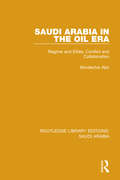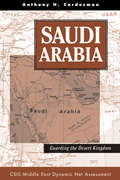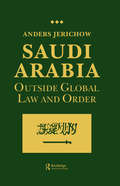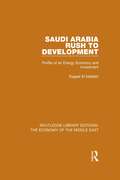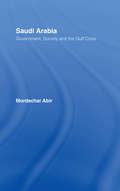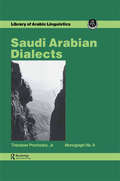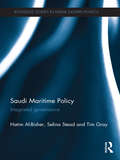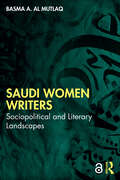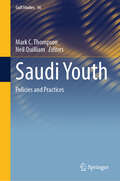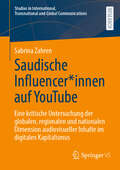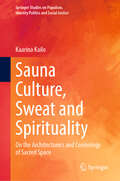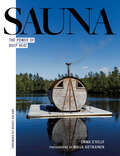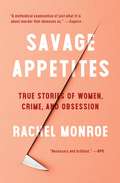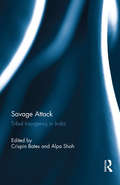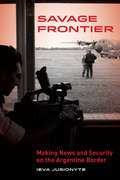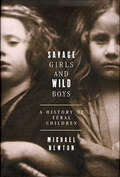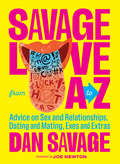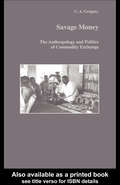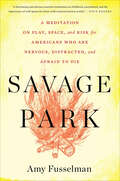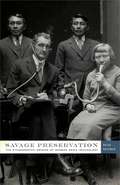- Table View
- List View
Saudi Arabia in the Oil Era (RLE Saudi Arabia): Regime and Elites; Conflict and Collaboration
by Mordechai AbirSaudi Arabia has undergone a rapid social and economic transformation. When Ibn Saud declared the nation a unified kingdom in 1932, the majority of its population was nomadic and lived in a state of poverty or semi-poverty. Now the processes of modernisation, financed by the exploitation of the country’s vast oil reserves, have produced a prosperous and predominantly urban population. However, this social change has not been without its tensions; the emergence of a rising middle class has called into question the monopoly of power of the House of Saud, its involvement in the kingdom’s economy and its oil and foreign policy, while the rapid urbanisation of the rural population has eroded the traditional social structures and has not solved, but in some cases promoted, social division. This book, first published in 1988, explores the recent history of the Saudi oil state in an analysis of the struggle for social and political power in modern Saudi Arabia.
Saudi Arabia: Guarding The Desert Kingdom (Praeger Security International Ser.)
by Anthony H CordesmanWith this multivolume study, Anthony H. Cordesman once again proves that he is a leading authority on the affairs of the Middle Eastern states. Cordesman led this comprehensive net assessment of the political, economic, energy, security (both internal and external), and military trends in each of the Gulf states, as well as the power projection cap
Saudi Arabia: Outside Global Law and Order
by Anders JerichowBased on interviews with sources ranging from dissidents to diplomats, the book takes the reader behind the wall of piety and medievalism that guards Saudi sensitivities. Discussing the ruling family's self-awarded birthright to wealth and power, Anders Jerichow questions whether it is possible to ignore the rules of the world and still enjoy the protection of the international community?
Saudi Arabia: Power, Legitimacy and Survival (The Contemporary Middle East)
by Tim NiblockSaudi Arabia provides a clear, concise yet analytical account of the development of the Saudi state. It details the country’s historical and religious background, its oil rentier economy and its international role, showing how they interact to create the dynamics of the contemporary Saudi state. The development of the state is traced through three stages: the formative period prior to 1962; the centralization of the state and the initiation of intensive economic development between 1962 and 1979; and the re-shaping of the state over the years since 1979. Emphasis is placed on the recent period, with chapters devoted to: the economic and foreign policy problems which now confront the state the linkages between Saudi Arabia and Islamic radicalism, with the relationship/conflicts involving Al Qaeda traced through from events in Afghanistan in the 1980s the impact of 9/11 and the 2003 Gulf War the identification of major problems facing the contemporary state and their solutions. Saudi Arabia provides a unique and comprehensive understanding of this state during a crucial time. This book is essential reading for those with interests in Saudi Arabia and its role in Middle Eastern politics and on the international stage.
Saudi Arabia: Profile of an Energy Economy and Investment (Routledge Library Editions: The Economy of the Middle East)
by Ragaei el MallakhSaudi Arabia is one of the most controversial and least known of the Arab nations. A land of massive contrasts – between its densely populated cities and its vast expanses of desert; between the recent poverty of its villages and the massive wealth created by oil, which is drawing a labour force from most of the neighbouring countries; between the aggressive technocratic and industrial thrust forward and the strongly traditionalist Islamic basis of the ruling ideologies – it has progressed to world prominence in a matter of years after centuries of little or no change. The change is not so much a surge, or even a thrust, as a rush into the industrialized and wealthy world. This book analyzes the problems and achievements of Saudi development and provides the first detailed critique of the Third Development Plan. First published in 1982.
Saudi Arabia: Society, Government and the Gulf Crisis
by Mordechai AbirThis much-revised edition of Professor Abir's Saudi Arabia in the Oil Era now includes consideration of both Gulf Wars. Abir examines the social and political forces that have shaped Saudi Arabia, including the impact of Islam and of Westernization, drawing heavily on Saudi sources. There is also essential analysis of regional security dilemmas and of the country's prospects in the post-Gulf War era.
Saudi Arabian Dialects
by Theodore ProchazkaFirst published in 1988. Arabic linguistics is developing into an increasingly interesting and important subject within the broad field of modern linguistic studies. The scope of this discipline is wide and varied, covering diverse areas such as Arabic phonetics, phonology and grammar, Arabic psycholinguistics, Arabic dialectology, Arabic lexicography and lexicology, Arabic sociolinguistics, the teaching and learning of Arabic as a first, second, or foreign language. The present work by Prochazka is the first general survey of the dialects of Saudi Arabia covering a wide range from north to south recording of linguistic variation in that vast region. It is particularly strong in covering a number of localities in the southwest and it is the first linguistic study of the dialect of the Ruwala bedouin of the northern desert. The work reveals a major division into two areal blocks: (i) the southern Hijaz and Tihamah and (ii) the Najdi and Eastern Arabian dialects.
Saudi Arabian Foreign Relations: Diplomacy and Mediation in Conflict Resolution (Routledge Studies in Middle Eastern Politics)
by René RiegerIn recent decades, Saudi Arabia has committed itself to playing the part of mediator in intra-national and international conflicts in the greater Middle East region. Examples include the two Saudi-introduced Arab Peace Initiatives of 1982 and 2002, mediation attempts between Algeria and Morocco in the West Sahara conflict, Iraq and Syria during the Iran-Iraq War and Iran and Iraq towards the end of their military conflict. Saudi Arabian Foreign Relations provides a new insight to current studies on Saudi foreign policy and mediation in international relations. The book offers a detailed analysis of Saudi Arabia’s intermediary role in the intra-state conflicts in Yemen, Lebanon and the Palestinian territories, and the successes and limitations of each. Additionally, it provides an updated examination of Saudi Arabia’s role towards resolution of the larger Arab-Israeli conflict. Saudi Arabian Foreign Relations contributes to a far deeper understanding of Saudi foreign policy, and therefore will be of great interest to students and scholars of Middle East Politics and International Relations.
Saudi Arabian Foreign Relations: Diplomacy and Mediation in Conflict Resolution (Routledge Studies in Middle Eastern Politics)
by René RiegerIn recent decades, Saudi Arabia has committed itself to playing the part of mediator in intra-national and international conflicts in the greater Middle East region. Examples include the two Saudi-introduced Arab Peace Initiatives of 1982 and 2002, mediation attempts between Algeria and Morocco in the West Sahara conflict, Iraq and Syria during the Iran-Iraq War and Iran and Iraq towards the end of their military conflict.Saudi Arabian Foreign Relations provides a new insight to current studies on Saudi foreign policy and mediation in international relations. The book offers a detailed analysis of Saudi Arabia’s intermediary role in the intra-state conflicts in Yemen, Lebanon and the Palestinian territories, and the successes and limitations of each. Additionally, it provides an updated examination of Saudi Arabia’s role towards resolution of the larger Arab-Israeli conflict. Saudi Arabian Foreign Relations contributes to a far deeper understanding of Saudi foreign policy, and therefore will be of great interest to students and scholars of Middle East Politics and International Relations.
Saudi Maritime Policy: Integrated Governance (Routledge Studies in Middle Eastern Politics)
by Tim Gray Hatim Al-Bisher Selina SteadBecause marine governance in most countries is sectoral, maritime policies are frequently fragmented, reactive, and even contradictory, meaning that marine resources are underutilized and poorly protected. To avoid these problems, the concept of integrated national maritime policy (INMP) has been developed. This book examines this concept, analysing its current application in four countries – Australia, Canada, UK and USA – whilst discussing at length how it might be applied to Saudi Arabia. Based on extensive fieldwork carried out in Saudi Arabia – including interviews with officials in government departments with maritime responsibilities, and a survey administered to 230 stakeholders – the book offers a unique insight into INMP in the Kingdom. The book provides a practical template for developing the political will and civil constituency in Saudi Arabia necessary for the introduction of INMP. In setting out in detail its benefits, this book could help build the momentum in Saudi Arabia required to implement the concept as well as attract other countries to do the same. A significant contribution to the growing literature on ocean governance, this book will be of great importance to policy makers and scholars of Middle Eastern studies, marine governance and comparative politics.
Saudi Women Writers: Sociopolitical and Literary Landscapes
by Basma A. Al MutlaqSaudi Women Writers: Sociopolitical and Literary Landscapes details the achievements of Saudi women fiction writers from the 1960s up to the present day, many of whose works have yet to be published in English translation.This book explores how various Saudi women writers’ works reflect deep social, religious and political changes over several key phases: the secularism of the 1960s and 1970s; the 1980s religious revival, or saḥwa; the post-saḥwa period; and the era of globalization. Engaging with intersectional feminism, that studies women’s texts as a multifaceted space of identity, power and agency, with the capacity to critique, and possibly dismantle, traditional hierarchies, especially amidst evolving social, religious and political landscapes. By examining the works of Samira Khashugji, Qmasha al-Olayyan, Omima al-Khamis, Zaineb Hefny, Badriya al-Beshir, Raja al-Sanea, Saba al-Herz and Warda Abdul Malik, this book charts a fresh course in literary criticism, moving beyond restrictive and monolithic perspectives.Saudi Women Writers: Sociopolitical and Literary Landscapes is an important and unique text which will be of use to both students and scholars of Gender Studies, Literature, Middle Eastern Studies, and Politics.The Open Access version of this book, available at http://www.taylorfrancis.com, has been made available under a Creative Commons Attribution-Non Commercial-No Derivatives (CC BY-NC-ND) 4.0 license.
Saudi Youth: Policies and Practices (Gulf Studies #16)
by Neil Quilliam Mark C. ThompsonThis edited collection develops a more balanced understanding of the dilemmas, challenges and opportunities associated with youth policy formulation and implementation in contemporary Saudi Arabia. It does so by considering the dilemmas, challenges and opportunities present in the contemporary Saudi sociopolitical, socioeconomic, and sociocultural spheres, as well as ways and means by which these can be addressed. Underpinning this is a comprehension of the necessity in understanding policies and processes as related to youth policy formulation and implementation. With regards to Saudi youth policy, decision makers want to be able to prioritize the most important issues. As such, policy and decision makers need ‘direction’ in terms of policy formulation, policy recommendations and policy implementation - that is, they are often searching for viable policies that resonate with young Saudis. Furthermore, lessons can be learnt from previous youth policy initiatives by asking: Why was thispolicy successful? If this policy failed, what were the reasons? Did this policy resonate with young nationals? This edited book unpacks the ways in which comprehending policies and processes are important for youth policy development and implementation in Saudi Arabia. It is relevant to policymakers, as well as scholars in Gulf Studies, and Middle Eastern Studies more broadly, as well as those in youth studies, area studies, and social studies.
Saudische Influencer*innen auf YouTube: Eine kritische Untersuchung der globalen, regionalen und nationalen Dimension audiovisueller Inhalte im digitalen Kapitalismus (Studies in International, Transnational and Global Communications)
by Sabrina ZahrenSeit 2015 wird die arabischsprachige YouTube-Sphäre von saudischen Influencer*innen dominiert. Sie orientieren sich an globalen Standards, die Sabrina Zahren als „globalen Konsens“ bezeichnet. Die Akteur*innen sind zudem in regionale Mediensysteme eingebettet, über die sie in Werbe- und Marketingstrukturen und, auf lokaler Ebene, in Nation-Branding-Strategien eingebunden werden. Diese Schlüsselaspekte, die „soziale Medien“ als Teil des digitalen Kapitalismus verorten, haben in den Studien zu arabischen Medien aus methodologischen und theoretischen Gründen bisher eher wenig Aufmerksamkeit bekommen. Das vorliegende Buch entwickelt daher eine hybride Perspektive, die die politische Ökonomie der digitalen Plattformen im Golf genauso mit einbezieht wie den Blick auf Influencer*innen und Creator Culture. Dazu wurden unter anderem fast 400 Videos kommerziell erfolgreicher saudischer YouTube-Kanäle qualitativ und quantitativ ausgewertet. Zudem zeichnet das Buch die Geschichte der Plattform YouTube in der Region nach und nimmt die Zusammenarbeit regionaler digitaler Industrien mit Tech-Konzernen des globalen Nordens (z.B. Google) genauer unter die Lupe.
Sauna Culture, Sweat and Spirituality: On the Architectonics and Cosmology of Sacred Space (Springer Studies on Populism, Identity Politics and Social Justice)
by Kaarina KailoThis book explores spiritual and sacred practices in Finnish saunas and Native North American sweat lodges through a comparative study. It also sheds light on ancient traditions from Ireland and Galicia, tracing their evolution and shared spiritual features. The book further analyzes gendered rituals, woman-centered lifeways, and cyclical worldviews rooted in rebirth and regeneration. This book shows how these practices reflect a deep, cross-cultural matrix of symbols celebrating Heaven and Earth. It presents the Delaware Sweat Lodge and Big House as prototypes of sacred structures for world renewal and their connections to sauna cultures worldwide. By defining key concepts from patriarchal, feminist, and Indigenous perspectives, this book challenges normative, unquestioned notions of the sacred and the divine. The book's interdisciplinary approach will appeal to students, scholars, and researchers of gender studies, Indigenous studies, cultural studies, religious studies, philosophy, and anthropology interested in a better understanding of how ancient rituals hold ecological significance for addressing today&’s planetary crises and social imbalances, revealing like-mindedness across diverse faith traditions.
Sauna: The Power of Deep Heat
by Emma O'Kelly'This beautiful and timely book will appeal to anyone looking to deepen their experience, with or without the added joy of a cold swim.' Kate Rew, author of The Outdoor Swimmers' Handbook'An essential guide to a movement reborn, blending modernity and tradition, design and wellness, community and nature.' Sarah Douglas, editor in chief, Wallpaper magazineThere is a new wave of sauna culture spreading throughout the UK and beyond. Saunas are being built in unique settings providing tech-free spaces in which to gather, share stories and enjoy nature. The tradition has a rich history, filled with rituals that encourage us to soak up the mental and physical health benefits of deep heat.This book honours the old, embraces the new, and plunges headlong into the transformative power of steam.'Smartly written and beautifully illustrated ... a celebration of a cultural resurgence and a reminder of the power of connecting with nature and something larger than ourselves.' Mikkel Aaland, author of Sweat
Savage Appetites: Four True Stories of Women, Crime, and Obsession (For True Crime Fans)
by Rachel MonroeA &“necessary and brilliant&” (NPR) exploration of our cultural fascination with true crime told through four &“enthralling&” (The New York Times Book Review) narratives of obsession.In Savage Appetites, Rachel Monroe links four criminal roles—Detective, Victim, Defender, and Killer—to four true stories about women driven by obsession. From a frustrated and brilliant heiress crafting crime-scene dollhouses to a young woman who became part of a Manson victim&’s family, from a landscape architect in love with a convicted murderer to a Columbine fangirl who planned her own mass shooting, these women are alternately mesmerizing, horrifying, and sympathetic. A revealing study of women&’s complicated relationship with true crime and the fear and desire it can inspire, together these stories provide a window into why many women are drawn to crime narratives—even as they also recoil from them. Monroe uses these four cases to trace the history of American crime through the growth of forensic science, the evolving role of victims, the Satanic Panic, the rise of online detectives, and the long shadow of the Columbine shooting. Combining personal narrative, reportage, and a sociological examination of violence and media in the 20th and 21st centuries, Savage Appetites is a &“corrective to the genre it interrogates&” (The New Statesman), scrupulously exploring empathy, justice, and the persistent appeal of crime.
Savage Attack: Tribal Insurgency in India
by Alpa Shah Crispin BatesIn Savage Attack: Tribal Insurgency in India the authors ask whether there is anything particularly adivasi about the forms of resistance that have been labelled as adivasi movements. What does it mean to speak about adivasi as opposed to peasant resistance? Can one differentiate adivasi resistance from that of other lower castes such as the dalits? In this volume the authors move beyond stereotypes of tribal rebellion to argue that it is important to explore how and why particular forms of resistance are depicted as adivasi issues at particular points in time. Interpretations that have depicted adivasis as a united and highly politicised group of people have romanticised and demonized tribal society and history, thus denying the individuals and communities involved any real agency. Both the interpretations of the state and of left-wing supporters of tribal insurgencies have continued to ignore the complex realities of tribal life and the variety in the expressions of political activism that have resulted across the length and breadth of the Indian subcontinent.
Savage Cinema: Sam Peckinpah and the Rise of Ultraviolent Movies
by Stephen PrinceMore than any other filmmaker, Sam Peckinpah opened the door for graphic violence in movies. In this book, Stephen Prince explains the rise of explicit violence in the American cinema, its social effects, and the relation of contemporary ultraviolence to the radical, humanistic filmmaking that Peckinpah practiced.<P><P>Prince demonstrates Peckinpah's complex approach to screen violence and shows him as a serious artist whose work was tied to the social and political upheavals of the 1960s. He explains how the director's commitment to showing the horror and pain of violence compelled him to use a complex style that aimed to control the viewer's response.
Savage Frontier
by Ieva JusionyteThis highly original work of anthropology combines extensive ethnographic fieldwork and investigative journalism to explain how security is understood, experienced, and constructed along the Triple Frontera, the border region shared by Argentina, Brazil, and Paraguay. One of the major "hot borders" in the Western Hemisphere, the Triple Frontera is associated with drug and human trafficking, contraband, money laundering, and terrorism. It's also a place where residents, particularly on the Argentine side, are subjected to increased governmental control and surveillance. How does a scholar tell a story about a place characterized by illicit international trading, rampant violence, and governmental militarization? Jusionyte inventively centered her ethnographic fieldwork on a community of journalists who investigate and report on crime and violence in the region. Through them she learned that a fair amount of petty, small-scale illicit trading goes unreported--a consequence of a community invested in promoting the idea that the border is a secure place that does not warrant militarized attention. The author's work demonstrates that while media is often seen as a powerful tool for spreading a sense of danger and uncertainty, sensationalizing crime and violence, and creating moral panics, journalists can actually do the opposite. Those who selectively report on illegal activities use the news to tell particular types of stories in an attempt to make their communities look and ultimately be more secure.
Savage Girls and Wild Boys: A History of Feral Children
by Michael NewtonSavage Girls and Wild Boys is a fascinating history of extraordinary children---brought up by animals, raised in the wilderness, or locked up for long years in solitary confinement.Wild or feral children have fascinated us through the centuries, and continue to do so today. In a haunting and hugely readable study, Michael Newton deftly investigates a number of infamous cases. He looks at Peter the Wild Boy, who gripped the attention of Swift and Defoe, and at Victor of Aveyron, who roamed wild in the forests of revolutionary France. He tells the story of a savage girl lost on the streets of Paris, of two children brought up by wolves in the jungles of India, and of a Los Angeles girl who emerged from thirteen years locked in a room to international celebrity. He describes, too, a boy brought up among monkeys in Uganda; and in Moscow, the child found living with a pack of wild dogs.Savage Girls and Wild Boys examines the lives of these children and of the adults who "rescued" them, looked after them, educated, or abused them. How can we explain the mixture of disgust and envy that such children can provoke? And what can they teach us about our notions of education, civilization, and man's true nature?
Savage Love from A to Z: Advice on Sex and Relationships, Dating and Mating, Exes and Extras
by Dan SavageAmerica's premier sex advice columnist takes on edgier-than-ever sex-positive topics with his signature candor in his first illustrated collection of adults-only essays, coinciding with the 30th anniversary of the Savage Love column. Dan Savage has been talking frankly about sex and relationships for 30 years, and has built an international following thanks to his sex-positive Savage Love column and podcast. To celebrate this milestone comes Savage Love from A to Z, an illustrated collection of 26 never-before-published essays that provides a thoughtful, frank dive into Savage's trademark phrases and philosophies. This hardcover book is for anyone who's had sex, is currently having sex, or hopes to have sex!Essays cover a variety of topics: • B Is for Boredom • F Is for Fuck First • G Is for GGG (Good Giving Game) • M Is for MonogamishWhether he's talking about issues like compatibility or specific sex acts, you can be sure he's giving it to you straight. Short excerpts from his classic columns kick off each essay and cheeky illustrations by his longtime collaborator Joe Newton complement the topic at hand. Savage has moved the needle toward a more open discourse around sex, relationships, and intimacy, and this book will both inspire and inform his legions of fans. An ideal stocking stuffer!
Savage Mind to Savage Machine: Racial Science and Twentieth-Century Design
by Ginger NolanAn examination of how concepts of &“the savage&” facilitated technological approaches to modernist design Attempting to derive aesthetic systems from natural structures of human cognition, designers looked toward the &“savage mind&”—a way of thinking they associated with a racialized subaltern. In Savage Mind to Savage Machine, Ginger Nolan uncovers an enduring relationship between &“the savage&” and the development of technology and its wide-ranging impact on society, including in the fields of architecture and urbanism, the industrial arts, and digital design.Nolan focuses on the relationship between the applied arts and the structuralist social sciences, proposing that the late-nineteenth-century rise of Freudian psychology, ethnology, and structuralist linguistics offered innovations and new opportunities in studying human cognition. She looks at institutions ranging from the Public Industrial Arts School of Philadelphia and the Weimar Bauhaus to the MIT Media Lab and the Centre Mondial Informatique, revealing a persistent theme of twentieth-century design: to supplant language with more subliminal, aesthetic modes of communication, thereby inculcating a deep intimacy between human habit and new technologies of production, communication, and consumption.This book&’s ultimate critique is of the development of the ergonomics of the spirit—the design of the human cognitive apparatus in relation to new aesthetic technologies. Nolan sees these ergonomics as a means of depoliticizing societies through aesthetic technologies intended to seamlessly integrate humans into the programs of capitalist modernity. Revising key modernist design narratives, Savage Mind to Savage Machine provides a deep historical foundation for understanding our contemporary world.
Savage Money
by C.A. GregoryThis volume is not simply another general theory of world system. It is a theoretically and ethnographically informed collection of essays which opens up new questions through an examination of concrete cases, covering global and local questions of political economy.
Savage Park: A Meditation on Play, Space, and Risk for Americans Who Are Nervous, Distracted, and Afraid to Die
by Amy Fusselman"A fascinating and daresay essential meditation on childhood, parenthood, and the importance of wild spaces for those wild creatures known as kids."—Dave Eggers How fully can the world be explored when you are focused on trying not to die? This is the question that lies at the heart of Amy Fusselman&’s Savage Park. America is the land of safety, of protecting children to make sure that nothing can possibly hurt them. But while on a trip to Tokyo with her family, Fusselman stumbled upon an adventure playground called Hanegi Playpark, where children sawed wood, hammered nails, and built open fires. Her conceptions of space, risk, and play were shattered. In asking us to reexamine fundamental ideas about our approaches to space and risk and how we pass these concepts down to our children, Fusselman also asks us to look at the world in a different way. Perhaps it isn&’t variety, but fear that is the spice of life. This startling revelation is at the heart of Savage Park, and will make readers look at the world in a whole new way. &“I yield to no one in my admiration for Amy Fusselman&’s work. Her new book, Savage Park, further explores with astonishing power, eloquence, precision, and acid humor her obsessive, necessary theme: the gossamer-thin separation between life and death.&” —David Shields, author of Reality Hunger &“In this unusually refreshing meditation (which reads like a novel), we are given a tour of the space around and within us. With poetic efficiency Amy Fusselman reveals what makes us savage or not; why secret, wild spaces are essential; and why playing should be taken seriously.&” —Philippe Petit, high-wire artist
Savage Preservation: The Ethnographic Origins of Modern Media Technology
by Brian HochmanDuring the late nineteenth and early twentieth centuries, writers and anthropologists believed that the world&’s primitive races were on the brink of extinction. They also believed that films, photographs, and phonographic recordings—modern media in their technological infancy—could capture lasting relics of primitive life before it vanished into obscurity. For many Americans, the promise of media and the problem of race were inextricably linked. While professional ethnologists tried out early recording machines to preserve the sounds of authentic indigenous cultures, photographers and filmmakers hauled newfangled equipment into remote corners of the globe to document rituals and scenes that seemed destined to vanish forever. In Savage Preservation, Brian Hochman shows how widespread interest in recording vanishing races and disappearing cultures influenced audiovisual innovation, experimentation, and use in the United States. Drawing extensively on seldom-seen archival sources—from phonetic alphabets and sign language drawings to wax cylinder recordings and early color photographs—Hochman uncovers the parallel histories of ethnography and technology in the turn-of-the-century period. While conventional wisdom suggests that media technologies work mostly to produce ideas about race, Savage Preservation reveals that the reverse has also been true. During this period, popular conceptions of race constructed the authority of new media technologies as reliable archives of the real. Brimming with nuanced critical insights and unexpected historical connections, Savage Preservation offers a new model for thinking about race and media in the American context—and a fresh take on a period of accelerated technological change that closely resembles our own.
